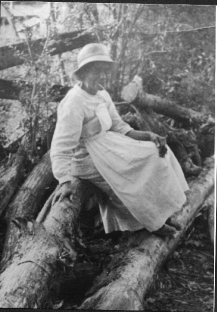Caroline Barr (1840-1940),  the Faulkner family maid, to whom Go Down, Moses is dedicated. Image found here.
the Faulkner family maid, to whom Go Down, Moses is dedicated. Image found here.
“They endured,” as readers of “Appendix: Compson” know, is the sum total of how Faulkner describes Dilsey, the Compson’s black maid in The Sound and the Fury. Glissant finds that a crucial textual touchstone in his effort to determine how Faulkner locates African-Amercans in his (Faulkner’s) vision of the South. If you read closely the excerpts from Glissant’s Faulkner book that I included in my previous post, two arguments emerge.
The first is that Faulkner confers not merely a sort of nobility upon black people relative to whites, he even holds them aloft–or prefers to hold them aloft–from History. They, unlike Faulkner’s whites, have no fate, no destiny to work out:
[Zack Edmonds] thought [as he looks at Lucas Beauchamp], and not for the first time: I am not only looking at a face older than mine and which has seen and winnowed more, but at a man most of whose blood was pure ten thousand years when my own anonymous beginnings became mixed enough to produce me. (Go Down, Moses 69, italics in the original).
Though Glissant does not say so explicitly, his early statement that Faulkner’s vision is that of epic invites the analogy: In that epic vision of the South, blacks are to the gods as whites are to mortals . . . except, of course, blacks are by and large unable to shape circumstances to their own advantage. Marginalized deities? The second is that, while Faulkner clearly sees such a positioning as honorific and ennobling of black people, Glissant and, by extension, African-Americans, see this (or should see this) as patronizing at best and, at worst, a denial of the same human agency that Faulkner’s whites have been cursed with.
All the above is why, as I’ve thought about all this, Go Down, Moses seems such a central text in the Faulkner canon–perhaps even the central text–and I’m not just saying that because if it weren’t for this novel I might very well not have written the dissertation (such as it is) that I did, much less be revisiting it now. In GDM, it seems clear, we find not only, through Ike McCaslin in particular, Faulkner’s clearest iteration of his conception of black people, we also find its most forceful rebuttal–as forceful as any that Glissant or any other critic could offer. The question that arises in my mind is, just how aware was Faulkner that his novel does that.
Continue reading →
Filed under: African-Americans, Edouard Glissant, Faulkner, history, mulattoes, narrative, novel, short fiction | 1 Comment »
 Lillian Smith. Image found here; Wikipedia entry here.
Lillian Smith. Image found here; Wikipedia entry here.




